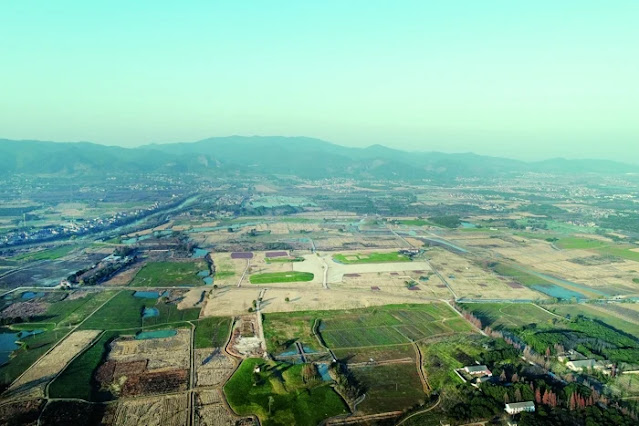About 5,300 years ago, an ancient civilization emerged in the east of China, building a brilliant city the likes of which had perhaps never been seen before in all of Asia – nor possibly even the whole world.
The archaeological ruins of Liangzhu City demonstrate numerous signs of social, cultural, and technological advancements for the period, especially in agriculture and aquaculture.
Sophisticated architectural features, meanwhile – including clever hydraulic engineering that enabled canals, dams, and water reservoirs – led to allusions of Liangzhu being a Neolithic "Venice of the East".
None of these marvels would last, however.
(Hangzhou Liangzhu Archaeological Site Administrative District Management Committee)
Above: Aerial view of palace area of Liangzhu.
After a single innovative millennium, the Liangzhu culture mysteriously collapsed around 4,300 years ago, and the ancient city was abruptly abandoned.
Exactly why has never been fully understood, although many have suggested some form of catastrophic flooding led to the sudden decline.
"A thin layer of clay was found on the preserved ruins, which points to a possible connection between the demise of the advanced civilization and floods of the Yangtze River or floods from the East China Sea," explains geologist Christoph Spötl from the University of Innsbruck in Austria.
"However, no clear conclusions on the cause were possible from the mud layer itself."
Now, we have a clearer picture of the deluge that drowned this astounding place.
In a new study, Spötl and an international team of researchers went far deeper than the ancient mud deposits, examining mineral formations (or speleothems) such as stalagmites from two underwater caves in the region, which preserve chemical signatures of climatic conditions long ago.
Stalagmites in Shennong Cave. (Haiwei Zhang)
Led by first author Haiwei Zhang from China's Xi'an Jiaotong University, their analysis of the stalagmite samples shows the collapse of Liangzhu City coincided with a period of extremely high precipitation that likely lasted for decades over 4,300 years ago, probably due to increased frequency of El Niño–Southern Oscillation conditions.
"This is amazingly precise in light of the temporal dimension," Spötl says.
"Massive monsoon rains probably led to such severe flooding of the Yangtze and its branches that even the sophisticated dams and canals could no longer withstand these masses of water, destroying Liangzhu City and forcing people to flee."
According to the researchers, previous instances of climate change in the Yangtze River Delta region may have also impacted other Neolithic cultures that inhabited the area before the Liangzhu society rose up in a period of dry and relatively stable environmental conditions.
But history and weather meant this prosperous city could not endure forever.
"Archeological studies show the presence of large-scale hydraulic complexes such as large earthen dams near the Liangzhu city, which were constructed between [5,300 and 4,700 years before present]," the researchers write in their study.
"This suggests that the Liangzhu society was effectively managing water resources by using hydraulic infrastructure for flood mitigation and/or irrigation to survive in a dry climate."
With time, however, that dry climate seems to have gotten progressively drier, culminating in a possible 'megadrought' around 4,400 years ago, at which point dam construction appears to have ceased, since existing dams would have been sufficient under the arid conditions.
And then the rains came, falling in two distinct burst periods between roughly 4,400–4,300 years ago.
"Our speleothem records, together with geochemical evidence of flood deposits above the Liangzhu culture layer, suggest that massive rainfall in the entire middle-lower reaches of the Yangtze River Valley might have induced fluvial flooding and/or overbank marine flooding transported by the Yangtze River plume and thus impeded human habitation and rice farming," the authors explain.
"Massive flooding and inundation due to poor drainage in the low-lying land may have forced the Liangzhu people to abandon their capital city and dwellings in the Taihu Plain, ultimately leading to the collapse of the entire Liangzhu civilization."
For hundreds of years afterward, humid conditions remained, during which time other ancient cultures temporarily rose up to succeed the Liangzhu – at least, until another megadrought likely led to the "final demise" of Neolithic human societies in the region.
At about the same time, Chinese society was about to begin a transformational new chapter, with the founding of the Xia dynasty in 2070 BCE, considered to be the first dynasty of China, led by Yu the Great.
"While many documents indicate that the leader Yu built the Xia Dynasty because he successfully managed river flooding, some studies suggest that Yu's control of the flooding can be ascribed to climate change," the researchers explain, noting that their own speleothem data also back up the idea.
"This observation provides new robust evidence that the rise of the Xia Dynasty occurred in the context of a major climate transition from wet to dry, in line with the Chinese historic records and previous studies."
Recommend this post and follow
The birth of modern Man




No comments:
Post a Comment
Stick to the subject, NO religion, or Party politics